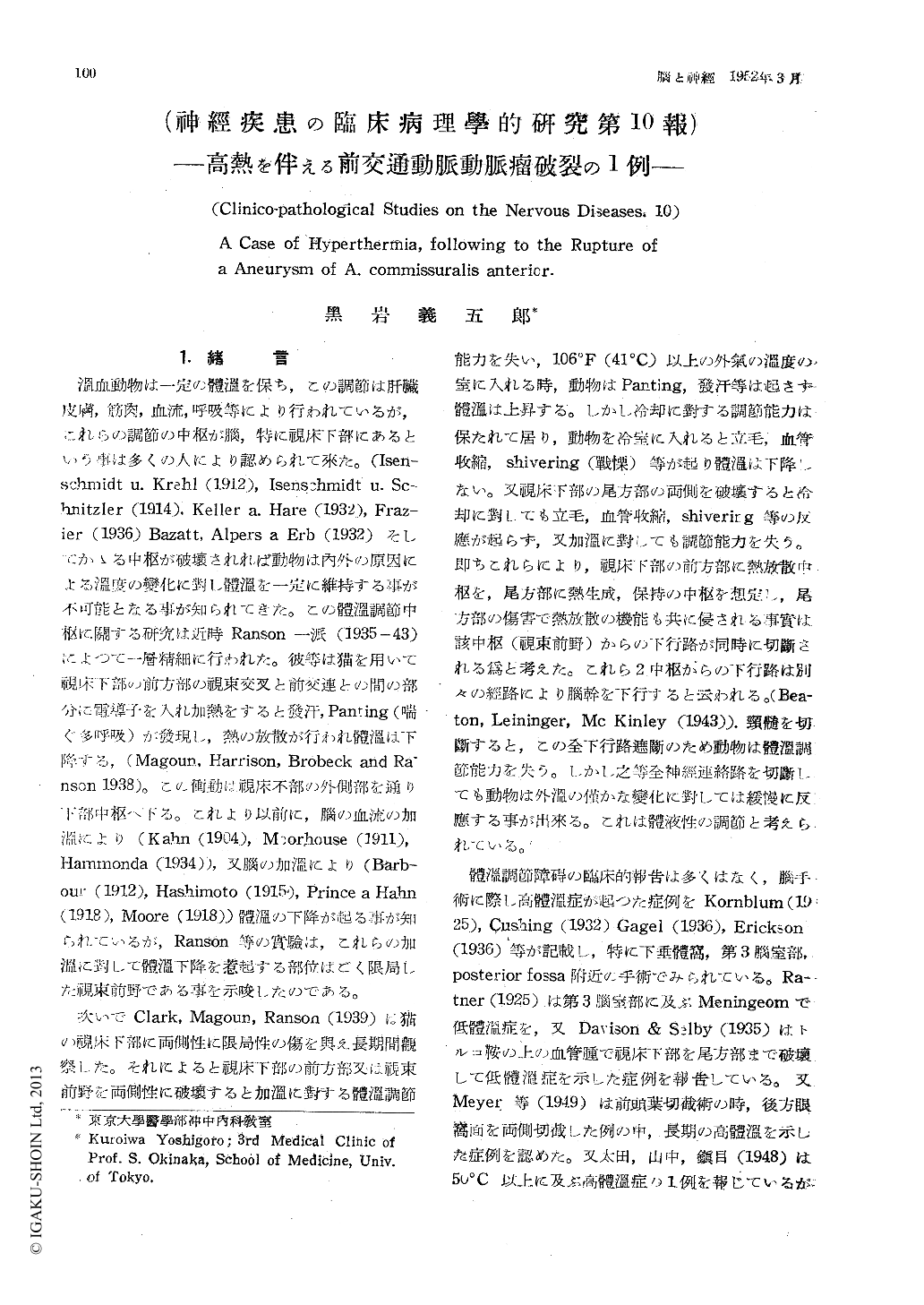Japanese
English
- 有料閲覧
- Abstract 文献概要
- 1ページ目 Look Inside
1.緒言
温血動物は一定の體温を保ち,この調節は肝臟皮膚,筋肉,血流,呼吸等により行われているが,これらの調節の中枢が腦,特に視床下部にあるという事は多くの人により認められて來た。(Isen-schmidt u. Krehl (1912), Isenschmidt u. Sc-hnitzler (1914), Keller a. Hare (1932), Fraz-ier (1936) Bazatt, Alpers a Erb (1932)そしてかゝる中枢が破壞されれば動物は内外の原因による温度の變化に對し體温を一定に維持する事が不可能となる事が知られてきた。この體?調節中枢に關する研究は近時Ranson一派(1935—43)によつて一層精細に行われた。彼等は猫を用いて視床下部の前方部の視束交叉と前交連との間の部分に電導子を入れ加熱をすると發汗,Panting (喘ぐ多呼吸)が發現し,熱の放散が行われ體温は下降する,(Magoun, Harrison, Brobeck and Ra-nson1938)。この衝動は視床不部の外側部を通り下部中枢へ下る。これより以前に,腦の血流の加温により(Kahn (1904), Moorhouse (1911), Hammonda (1934)),又腦の加?により(Barb-our (1912), Hashimoto (1915), Prince a Hahn(1918), Moore (1918))體温の下降が起る事が知られているが,Ranson等の實驗は,これらの加温に對して體温下降を惹起する部位はごく限局した視束前野である事を示唆したのである。
次いでClark, Magoun, Ranson (1939)は猫の視床下部に両側性に限局性の傷を與え長期間觀察した。それによると視床下部の前方部又は視束前野を両側性に破壞すると加?に對する體?調節能力を失い,106°F (41℃)以上の外氣の?度の室に入れる時,動物はPanting,發汗等は起さす體?は上昇する。しかし冷却に對する調節能力は保たれて居り,動物を冷室に入れると立毛,血管收縮,shivering (戰慄)等が起り體?は下降しない。又視床下部の尾方部の両側を破壞すると冷却に對しても立毛,血管收縮,shivering等の反應が起らず,又加?に對しても調節能力を失う。即ちこれらにより,視床下部の前方部に熱放散中枢を,尾方部に熱生成,保持の中枢を想定し,尾方部の傷害で熱放散の機能も共に侵される事實は該中枢(視束前野)からの下行路が同時に切斷される爲と考えた。これら2中枢からの下行路は別々の經路により腦幹を下行すると云われる。(Bea—ton, Leininger, Mc Kinley (1943)).頸髄を切斷すると,この全下行路遮斷のため動物は體?調節能力を失う。しかし之等全神經連絡路を切斷しても動物は外?の僅かな變化に對しては緩慢に反應する事が出來る。これは體液性の調節と考えられている。
I have reported a case of the subarachno-ideal hemorrhage, which showed very high fever.
Case: a man, 58 years old.
He complained frequently the feeling of co-ngestion, dizziness, palpitation and sleeplessn-ess since several years ago. In 1949. X. he camplained nausea, vomiting, headache and his consciousness was affected severely.
Kernig's sign, stiffness of the neck were observed, no paralysis.
Reflexes: loss of abdominal reflex, loss of knee jerk, and no pyramidal sign. Cerebros-pinal fluid, initial pressure 295mm H 2O, Que-ckenstedt's sign negative, hemorrhagic.
His temperature raised very high (over 40℃) from the onset of the present attack, pulse rate 120/min., respiratory rate 30/min. Slight leucocytosis (9800).
No marked physiological findings indicating any pyogenic infection, and high doses of peni-cillin was administrated, but his fever did not decreased.
In several days he died
Autopsy findings: No infection of the lung or other viscera.Brain. Diffuse subarachnoideal hemorrhage at the lower half of the cerebral hemispher. At the medial surface, just below the rostral part of the corpus callosum a relatively cir-cumscribed blood clot, finges-tip sized, was found. In the midst of this blood clot a ruptured aneurysm of the anterior communi-cating artery was observed.
This blood clot located at the preoptic area,
just rostral to the hypothalamus,
Thinking about the pathogenesis of the present high fever, there may be 2 factors.
1. diffuse subarachnoideal hemorhage.
2. the blood clot localized in the preoptic area. Only by the former cause this fever-seems to be unusual high. The preoptic area, according to Ranson and his collaborators, considered to be the center of the heat loss, the destruction of which followed hyperther-mia, then I consider the later cause might be responsible chiefly for the present high fever.

Copyright © 1952, Igaku-Shoin Ltd. All rights reserved.


